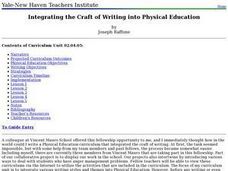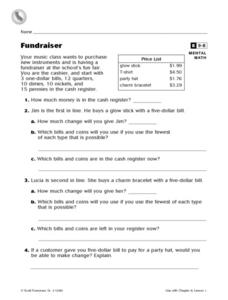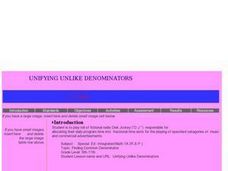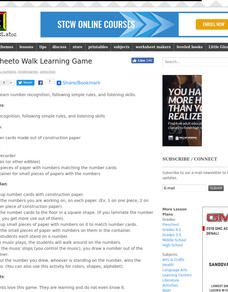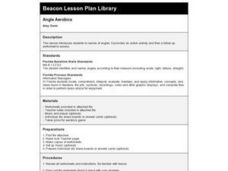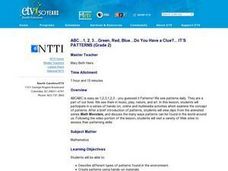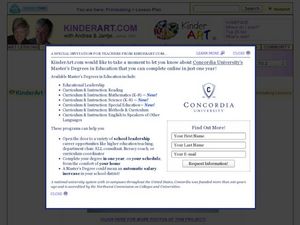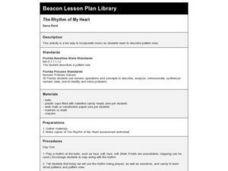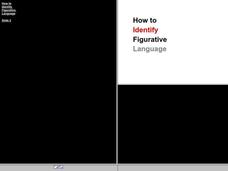Curated OER
Lines of Symmetry
Students practice dance to divide the space or body shape into equal sections to create symmetry in dance. In this symmetry lesson, students practice symmetrical and asymmetrical movements in dance. Students participate in move and...
Curated OER
Quel temps fait-il?
Hit all the basics with this lesson, focusing on weather, greetings, and dates! Start by singing a weather related song ("Quel temps fait-il by Barbara MacArthur is suggested), and then read a story about getting ready for school. The...
Curated OER
My Family and Our Nationality
After completing the activities included here, your beginning foreign language speakers will be able to name family members, identify a family's place of origin, and write short sentences about family members. They start by listening to...
Smithsonian Institution
Watching Crystals Grow
Amazing science can sometimes happen right before your eyes! The class gets cozy as they watch crystals grow. They use Epsom salts, rocks, and food coloring to create crystals. They'll observe the entire process, documenting every step...
Curated OER
Woody Guthrie: Life and Art
Woody Guthrie will capture the imagination of even your most reluctant learners. Using his work, your class will develop their skills in non-fiction reading comprehension, interpreting primary source material, and use of multiple forms...
Curated OER
My Many Colored Days
Students explore feelings. In this mental health cross-curriculum lesson, students listen to My Many Colored Days by Dr. Seuss and discuss their own moods and feelings. Students sing related songs, write about feelings, and...
Curated OER
Follow Your Dreams: Career Goals
It is so important for impending high school graduates to start thinking about their potential careers. Here, they discuss the persistence of Blondie Hasler and his impressive transatlantic trip. They follow various routes on a map and...
Curated OER
Integrating the Craft of Writing into Physical Education
Incorporate writing into your physical education class. In groups, learners unscramble a list of words related to exercise and use them in their journal writings. Using their name, they write one word related to physical activity that...
Curated OER
Dance is B.E.S.T.: Time
Students demonstrate dance activities and rhythm activities to whole, half, quarter, and eighth notes. They clap and move to notes individually and in 16 count metric phrases. As they create different 16 count metric phrases and...
Curated OER
Fundraiser
In this money problems worksheet, learners solve 4 story problems that pertain to buying merchandise and making change in a booth at a school fair.
Curated OER
Unifying Unlike Denominators
Students play roll of fictional radio disk jockeys. They allocate their daily program time into fractional time slots for the playing of specified catagories of music and commercial advertisements.
Curated OER
The Cheeto Walk
Pupils walk around numbered tiles on the floor as music plays. When the music stops, a number is drawn and if they are on that number they win reward (Cheetos or other snack.)
Curated OER
Angle Aerobics
Third graders review angle criteria and then stand. They demonstrate with their hands each type of angle called out by the teacher: right, acute, or obtuse. Music is added and students follow teacher in an angle aerobics class peppered...
Curated OER
Statistics and Probility
Seventh graders collect data and make predictions. In this geometry lesson, 7th graders work in tiers collecting data and plotting it. They make inferences and predictions about their collected data.
Curated OER
ABC...1, 2, 3...Green, Red, Blue...Do You Have a Clue?... IT'S PATTERNS
Second graders view clips from the animated series Math Monsters, and discuss the many ways patterns can be found in the world around us. Following the video portion of the lesson, 2nd graders visit a variety of Web sites to assess their...
Curated OER
When is a Block, not a Block?
Students use a stamped shape image to create a piece of imaginative art. In this stamped art lesson, students use a stamped shape as a starting point to create their own imaginative piece of art that incorporates the stamped shape.
Curated OER
Compare Numbers
In this number comparisons worksheet, students use the table for the 'Enrollment in a Music School' to compare numbers and answer the six word problems.
Curated OER
The Rhythm of My Heart
First graders describe pattern rules. They use the rhythm being played on a bell and candy hearts to explore patterns and pattern rules. This is an especially good instructional activity to use around Valentine's Day.
Curated OER
Recording Artist and MP3 Players
Students explore the concept of being a recording artist. In this recording artist lesson plan, students determine the costs of producing various music products such as a demo tape, 8-track tape, and a record deal. Students discuss...
Curated OER
How To Identify Figurative Language
Students investigate writing techniques by analyzing a chart. In this figurative language lesson, students define similes, metaphors and identify the difference between them and personification. Students demonstrate their understanding...
Curated OER
Mummies Made in Egypt
Students use maps to locate information on Egypt, then create their own maps to display knowledge gained from the lesson and Web sites. They recognize, create, and describe the pyramid's geometric shape in three-dimensional forms.
Curated OER
EXCEL It!
Students surf the Web gathering information about graphs. The data collected is incorporated into an Excel spreadsheet and graphs of varying nature generated to further enhance student understanding.
Curated OER
Sew, You Want To Quilt?
Students become familiar with the achievements of the artist Faith Ringgold. They take notice of the patterns in their environment. They connect the mathematical concept of patterns to create a class quilt.
Curated OER
Hands On: Plot Points on a Coordinate Grid
In this solving coordinate grid word problem activity, students plot points, order pairs, identify horizontal and vertical lines, and find distances to solve problems. Students solve six problems.







